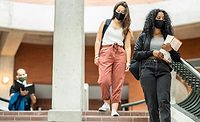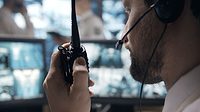Security Strategy
Striking the balance: How visible should campus security be?
Four security leaders talk strategies for finding the right level of visibility for effective safety and security operations within higher education.

Flashvector/ iStock / Getty Images Plus via Getty Images
For colleges and universities, public safety can be a balancing act.
On the one hand, campus police want to be seen. “We want to display visibility for the deterrence value, and also to demonstrate availability: That we are here when you need us, making sure that your surroundings are secure,” says Ruth Evans, Arcadia University Public Safety Director.
At the same time, campus security officers don’t want to come on too strong. “What we’re trying to avoid is an unnecessary feeling of surveillance and overwhelming police presence,” says University of Maryland Chief of Police and Director of Public Safety David Mitchell.
So, how can campus safety and security teams strike a balance when it comes to the visibility of security on campus without overwhelming students, staff and visitors? We asked four campus security leaders to talk about their strategies.

David Mitchell, University of Maryland Chief of Police and Director of Public Safety. Image Courtesy of Mitchell
Mentoring and Caring
At Arcadia University, with about 4,000 students, 2,000 of whom live on campus, campus security aims to be a source of support. “We do a lot of mentoring and caring. That’s the atmosphere we’ve created here,” Evans says. “We don’t want to appear overly aggressive and too authoritative.”
To generate that caring and supportive atmosphere, Evans takes a strategic approach to the ways in which security personnel are deployed on campus.
“We divide our patrols. If I start out the day patrolling buildings A, B and C, then later this afternoon I may change patterns and patrol sectors C, A and then B, so it’s not too much and not too little,” Evans says.
Evans adds that the campus is divided into three sections, with one officer responsible for all buildings and locations within their sector. How they patrol that sector is up to the officer’s discretion, she says. “Of course, we pay special attention to sensitive areas, like the chemistry labs, and to heavily-occupied events, like athletics, where we’re having a lot of community members engaged. At big events you’re obviously going to have a much more visible presence,” she says.
In order to ensure campus security officers remain visible when needed, Evans leverages a combination of security assets. “We do vehicle patrols, we have golf carts, and most of the time we’re on foot. The golf cart can be on the sidewalks, the walkways. The vehicle can patrol the exterior of campus, especially at our three entrances,” she says. “You really need that mix of resources.”
Evans encourages officers not just to be seen, but also to have meaningful engagements with students. “I was on patrol with one of my officers and he pulled over so that we could talk to a student. He wanted to follow up with her to see how she did on an exam. I thought that was phenomenal customer service,” she says.
“We talk about that in the initial interview process, and before they even start their training: That we want them to be polite, courteous and authoritative, but also supportive,” she says. “Visibility should be part of that. I don’t hear people saying that they never see public safety, or that public safety doesn’t care. We want them to know that we are available 24/7.”

Ruth Evans, Arcadia University Public Safety Director. Image Courtesy of Evans
Community Engagement
At Virginia Commonwealth University (VCU), Chief of Police John Venuti says visibility is interwoven with a larger strategy of community engagement.
“There’s presence and visibility, and then there’s engagement. We really use both of those goals as tools to increase the feeling of safety on VCU’s campuses,” he says.
Being present and being visible is one thing, but drawing the attention of community members specifically is just as critical, he says. “When we engage with members of the community, it causes people to pause, to look at us. Engagement is really designed to break down barriers, and it’s a really important part of our strategy.”
For example, at night, when students may feel less safe, campus police make an effort to let students know they are there. “Our offices will turn on their blue lights so that they are highly visible, especially at night,” Venuti says. “You can see a police car half a block away if it has no lights on, but if it has lights on, you can see it from much further away.”
The department also is making an effort to adapt its visible strategies to align with changing circumstances.
“Some of the feedback I got from a particular area at VCU was that there are not as many people working in our buildings because of COVID,” he says. “We not only increased the presence and visibility in that building, but we created a VCU-wide initiative. We’ve got over 220 buildings here at VCU on both campuses, and coming back from the pandemic, staff may be feeling isolated. To make them feel safer, we’re using a combination of building walks as well as engagement.”
He describes the VCU campus police’s strategy of engagement as a key way to strike that balance between being visible, while not being overbearing. This strategy sometimes requires that campus police actually be less visible on certain occasions, according to Venuti.
“Campus law enforcement in the past has responded to everything, just because we’re 24/7, we’re the people that are always here,” he says. “Today, we only want to send the police when the police are necessary.”
To that end, Venuti has modified how the campus security team completes status and welfare checks on students. “Parents may call the police department, but we will coordinate with residential housing to make that contact or conduct that check, unless there are imminent, ongoing life-threatening circumstances,” he says.
Venuti is also in the midst of creating an additional alternative response unit — the VCU Safety Ambassadors. The unit will aim to achieve that intended balance of support, community engagement and safety and security.
“These will be non-sworn civilian employees and they will be in a vehicle that looks almost the exact opposite of what a police vehicle looks like. They are going to have a training portfolio of some mental health experience, some social work experience,” Venuti says. “We’re looking forward to working with the VCU School of Social Work on internships for this program, and we’re going to use them in those situations where we don’t need a police officer to respond.”

John Venuti, Chief of Police, Virginia Commonwealth University. Image Courtesy of Venuti
Active Listening
David Mitchell of the University of Maryland (UMD) says that the police and public safety team’s focus is on the quality of encounters with students.
“We’re asking our officers to engage in conversations, to be present and actively listen to what students have to say,” he says. “Given the tumultuous time that we’ve had in the past several years in particular, my officers have asked me: How do we regain public trust? My response is always that we do that one contact at a time, one traffic stop at a time, one community engagement at a time.”
In order to have those meaningful encounters, campus safety has to cover a lot of ground. With 40,000 students and 15,000 to 20,000 staff and faculty, UMD is a small city on two and a half square miles. “To cover that, I’ve got an authorized strength of 104 security staff, and we’re about 20 short right now,” Mitchell says.
To maintain visibility, Mitchell says campus safety uses different strategies depending on the time of day. “At night, we patrol with our lower lights on so that we’re visible. During the day, we do it on foot, on a bicycle and on a motorcycle,” he says.
“We’re trying to cover a lot of ground, but we’re also trying to make a lot of contacts. When we’re on bicycles and students are traversing campus, going to classes and so forth, we’re extremely visible. And it’s easier to get around some of the nooks and crannies of our campus on bicycle and motorcycle than it is with a vehicle,” Mitchell says.
In addition to personnel, the team leverages some 600 cameras in its security operations center to ensure patrols are visible in the right places. Students help to monitor that feed, “because they know where to look,” Mitchell says.
In addition to visibility, UMD utilizes strategies to support students and staff as well as provide community engagement. “We have a comfort dog named Teddy the Terp; he wears a vest that says he’s a comfort dog and says, ‘I like belly rubs.’ Students literally go crazy over him,” Mitchells says.
“I’ve got five anti-IED dogs — bomb dogs. That’s one thing. But Teddy is a star. He helps us demonstrate that we’re not just out in a traditional police role,” he says. “Community engagement is important: Students may come here with a heightened state of anxiety, and when they see us lighthearted, engaging — not in enforcement mode — that’s really important. So we go out there, and we bring Teddy.”

Bryce Wickard, Director of Safety, Messiah University. Image Courtesy of Wickard
Community Support
At Messiah University, Director of Safety Bryce Wickard says finding the right level of visibility helps to drive the student buy-in he needs to mount an effective safety operation.
“We need the support and cooperation of the members of our community. We rely on them to be our supplementary eyes and ears,” he says. “If the members of the community feel like they’re being over-policed, they might pull away from that, be less likely to report unsafe behavior or criminal activity.”
Wickard says the focus of the campus safety team is promoting and fostering strong ties with students and the community. “We are intentional in actually connecting. I would call it ‘relational visibility,’” he says. “We have walkthroughs, for example, where we have assigned every officer a residential building on campus, and they are expected on every shift that they work to walk through the floors of that building. We want our officers to intentionally build relationships, to stop if they see someone in the hallway and introduce themselves.”
That’s a shift from the way things used to be done. “Before we did this, anytime an officer went into a residential dorm, you could see the reactions of the students: Somebody’s in trouble,” he says. “We want to change that to where, when you see a safety officer, it doesn’t mean there’s something bad happening.”
In order to drive security in this way, Wickard says strong buy-in from the entire team is needed. “This starts with who you hire for your officers. When I’m interviewing, I look for character as much as credentials,” he says.
“You can train somebody to drive a car, but it’s much more difficult to train people to have a passion for the wellbeing of the constituency,” Wickard says. “When we interview, we are asking people: What is your interpretation of visibility when you’re out on campus? What message do you want to send? With our strategy for visibility, we have to have people with the same vision.”
Looking for a reprint of this article?
From high-res PDFs to custom plaques, order your copy today!






